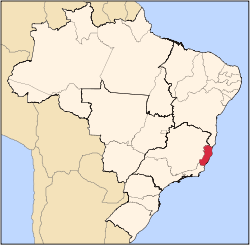Baixo Guandu
| Baixo Guandu | |||
|---|---|---|---|
| Municipality | |||
| The Municipality of Baixo Guandu do Espírito Santo | |||

Igreja da Matriz
|
|||
|
|||
 Location in the State of Espírito Santo |
|||
 |
|||
| Coordinates: 19°31′08″S 41°00′57″W / 19.51889°S 41.01583°WCoordinates: 19°31′08″S 41°00′57″W / 19.51889°S 41.01583°W | |||
| Country |
|
||
| Region | Southeast | ||
| State |
|
||
| Founded | June 8, 1935 | ||
| Government | |||
| • Mayor | Lastênio Luiz Cardoso (2009-2012) | ||
| Area | |||
| • Total | 917.88 km2 (354.40 sq mi) | ||
| Population (2009) | |||
| • Total | 29.891 | ||
| • Density | 31.11/km2 (80.6/sq mi) | ||
| Demonym(s) | Guanduense | ||
| Time zone | UTC-3 (UTC-3) | ||
| Postal Code | 29730-000 | ||
| HDI (2000) | 0.71 – medium | ||
| Celebration day | April 10 | ||
| Website | www |
||
Baixo Guandu is a municipality located in the Brazilian state of Espírito Santo that was founded on April 10, 1935 and established as a city on June 8, same year. The city's celebration day is April 10. Its population was 29,891 (2009) and its area is 918 km². The area is most well known for its exports of coffee, especially from the high mountains of the district of Alto Mutum Preto. The main watercourse through the municipality is the Rio Doce river ("Doce" means sweet in Portuguese) whose basin (of 83,500 square kilometers) is composed of 222 municipalities.
Situated in the valley of the Rio Doce, Baixo Guandu occupies a prominent place in the political and socio-economical development of the Espírito Santo.
The county was created on April 10, 1935, it was initially colonized by migrants from Cantagalo Rio de Janeiro and European immigrants, especially from Italy and Germany.
The history of Baixo Guandu is directly linked to the pioneering spirit that marked the beginning of the 20th century in the valley of Rio Doce. The rails of the first train arrived in 1907 and the economic activities were intensified. The abundant wood was removed and taken by train to the capital.
According to the testimony of bandeirantes and travelers who have visited the lower Rio Doce since the second half of the 20th century by the middle of last century, the Indians native sons and daughters were masters of the region between Rio Doce and the River São Mateus.
The first penetration in the territory of the Baixo Guandu, the former jurisdiction of the municipality of Colatina occurred in 1875, when the major José Vieira de Carvalho Milagres, veteran Paraguayan War reaches the confluence of the Rio Doce river Guandu and there down the core leading to the city.
The colonization of the region, initiated by major Milagres, had his base-grounded in the work of European immigrants of various origins, located in the colonial core of Afonso Pena, today Ibituba.
The foreign colonists settled in the valley of the guandu and the other Ribeirão do Lage. On both sides, there are still today the hallmarks of the European heritage in the region.
...
Wikipedia


